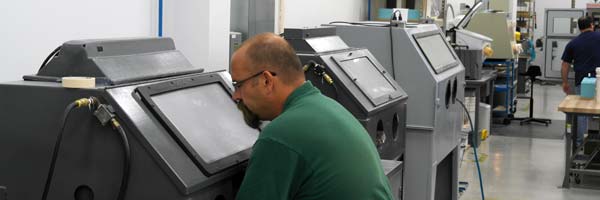
Bead Blasting: An Ideal Finishing Process for Additive Manufacturing
Just like other building processes, 3D-printing usually involves a finishing step. This could be sanding, polishing, or one of many other types of finishing. 3D-printed parts need finishing because the process of additive manufacturing usually leaves traces of the building process. The traces could be “lines” where the layers of the build come together, or could be tiny marks where manufacturing supports were removed.
Have you considered which type of finishing you need for your 3D-printed parts? Bead blasting offers a functional matte finish that might be ideal for your application. Here’s a quick introduction to bead blasting—what it is, and why you might want to choose it.
What is bead blasting?
Bead blasting is a finishing technique for 3D-printed parts. It’s an abrasive blasting method, which means that it is similar to sandblasting and water blasting (pressure washing). In bead blasting, fine beads of plastic, glass, or another substance are forcibly sprayed over the surface of a part. The type of beads are chosen depending on the part’s material in order to smooth the finish of the part without damaging it.
Why use bead blasting?
Bead blasting creates a uniform matte finish over the surface of the part. Most customers consider this the standard finish—build markings are smoothed out, but additional high quality finishing has not been applied. It’s ideal for assessing a prototype, or for finishing a piece that doesn’t need a “show ready” finish. Bead blasting also makes it easier to photograph parts because it reduces the light reflections from the part’s surface. For pieces that will be used for sales meetings and trade shows, most customers prefer a higher quality finish.
How bead blasting compares to sanding
Sanding
Sanding is the traditional method of finishing additive manufactured parts. Sanding is performed by hand and is a reliable choice for all but the smallest or most detailed parts. Sanding can reduce the tolerance of a part, because it is hard to control exactly how much material is removed by sanding.
Bead Blasting
Bead blasting is performed with a hand-held blaster gun within an enclosed chamber. It is a good technique for finely detailed and small pieces that would be difficult to sand. It can offer more precision than sanding due to the bead gun’s uniform output per second. Bead blasting is limited to parts that can fit inside the blasting chamber, so this technique might not work for larger parts. Bead blasting generally takes less time than sanding.
Compare Additive Manufacturing Finishes
See our finishing guide for a table comparing additive manufacturing finishing techniques, along with descriptions. ProtoCAM offers all of these techniques, and we’re always innovating new ones.
Contact Us for Top-Quality Finished Parts
If you’re not sure which finishing technique is best for your product, we’re happy to help you decide. Send us a message here, or request a quote. No matter the destination of your finished part, we’ll help you choose the best finishing technique for your goals and your budget.
